|
Contemporary use of this phrasing often alludes to engaging in a certain experience with a calm state of attentiveness, guided by intuition rather conscious thought or effort. It is also interpreted as the activity itself allows a practitioner to achieve a calmed state by engaging in the activity. While the Western interpretation of Zen may be more of a mix of Buddhism, Taoism, and Confucianism influences, it’s roots first sprouted in Zen Buddhism in the 5th century CE. Zen Buddhism focuses heavily on the use of meditation to achieve enlightenment and understanding “the meaning of life”. Many tree climbers experience a state of peace and tranquility when they are high in the branches above. Having a calmed state of mind when sitting in the top of a tree lends itself to practicing mindfulness and meditation. Given meditation involves clearing the mind, the climbing process itself can provide a point of focus, resulting in one’s mind letting go of the everyday worries and concerns that plague our thoughts in our daily routine. Therefore, some people see climbing as meditative in its nature. The Path to Enlightenment In their simplest forms, “The Zen of”, Zen Buddhism, and any of the branches or schools of Buddhism are focused on reaching enlightenment; or attaining the full comprehension of the true nature of all things and life itself. The original Buddha put forth that life is filled with struggle & suffering, which occur when we harbor desires, are guided by our ego, or behave in immoral ways. He went on to present a path we can follow to reduce suffering and find ultimate happiness and inner peace. This path is the noble Eightfold Path. Through following the behaviors in the Eightfold Path, one can escape the suffering associated with the human experience. Escape suffering, reach nirvana, become enlightened. Zen Buddhism emphasizes the practice of meditation as being the key to reaching enlightenment, whereas meditation is just one of the 8 steps put forth by the Buddha. The 8 components in the Eightfold Path include having the right:
Upon considering “the Zen of Tree Climbing”, I find a natural how the philosophical principles in the Eightfold Path are manifested in the tree climbing process.  Climbing the Eightfold Path RIGHT VIEW: Having the right view refers to having the understanding that your actions have consequences, which can lead to suffering. Therefore, you should pursue the knowledge that will help you see and understand things as they really are as this will help you steer clear of suffering. If you can picture yourself standing at the base of a tall tree, looking up at the branches high above, it’d likely strike you that climbing the tree could result in injury. Most of us are not as carefree, or oblivious to consequences as we were as kids. Knowing there is risk involved is usually enough reason for many people to not even consider heading up. With a little training and knowledge however, we can learn what we can look for and how to read subtle details to determine if a tree is suitable for climbing. We can also use this knowledge to make determinations on how to climb the tree while minimizing our risks for injury. It also helps to know that there is specialized equipment and how it can be used to climb tall trees and minimize the associated risks with being at-height. I’m sure you don’t need to have climbed a tree to imagine it being far more enjoyable and rewarding if we do so without injuring ourselves. Having the knowledge and understanding of how to determine if a tree is suitable for climbing can help minimize your exposure to risk of injury & suffering.  RIGHT THOUGHTS/INTENTION: When it comes to fostering the right thoughts or having the right intention, we are looking at cultivating healthy thoughts as they determine our state of mind. One of the biggest obstacles and hindrances new climbers encounter is comparing themselves to others. It appears that that some people are inclined to judge themself by comparing to others, yet how someone else is doing has no bearing on how you will do. It makes no difference if he is doing better than you or if she is climbing faster than you, your path is up your rope, not someone else’s. If your thoughts are focused on how other people are doing, especially if those thoughts are envious or negative in nature, you will lose focus of what is most important - your own progress & success. To reach your goal, you will need a positive mindset and your focus should be on your technique and driven by your motivations. Further, it appears to be reflex for some people to start right off the bat saying, “I’m not good at this” or “I can’t do it.” It’s been said, “whether you think you can or think you can’t, you’re exactly right.” That’s the power of thought. Positive thoughts cultivate a healthy mindset. RIGHT SPEECH: Right speech refers to refraining from divisive and abusive speech. Words of praise and encouragement have a positive impact on others who are headed up on their own journey. Such words can lift a person’s spirits and bring them joy. Whereas using words of criticism and judgement have the potential to negatively impact their psyche and performance. Think back to the idea above; how another person is doing has no bearing on whether you achieve success of reaching your goal. We can either use words of positivity or negativity, keeping in mind that your words also impact your mindset. Abusive language towards others will negatively impact your own well-being. Maintaining positive thoughts and verbalizing them has a synergistic and karmic effect on your own state of mind.  RIGHT ACTION: Right action is to refrain from unwholesome & harmful behavior. Instead, behave in accordance with truth and for the goodness of others. During a climb, we are interacting with the tree and other climbers. Given our reliance upon the condition of the tree to keep us safe, common sense tells us to respect the tree and refrain from causing injury or harming the tree for our own sake. Likewise, our actions should not be such that they cause harm to others, whether they are enjoying the area and tree from the ground or in the branches alongside us. This also goes for the animals and organisms that rely on the tree for food and habitat.  RIGHT LIVELIHOOD: Right livelihood refers to avoiding occupations that directly or indirectly harm others, in essence, provide for your needs in a way that is moral and respects all life. Climbing higher takes energy and therefore we often take breaks to catch our breath and rest our muscles. Once we stop on a branch for a breather, we are able to look beyond the branches and leaves that envelop us. Our field of view has expanded far beyond that which we could see from the ground. This elevated perspective lends itself to a broader understanding of where you are in relation to the ground below and where the tree is situated in relation to its surroundings and the community. Viewing the broader picture, we have the opportunity to see how everything interacts and is connected to something beyond just itself. Each individual has influence on everyone else, and it is in your control to be a positive influence on those you interact with and those who are impacted by your actions.  RIGHT EFFORT: Putting forth the right effort means that we should refrain from unwholesome thoughts. At the beginning of a climb, it is common to have a sense of apprehension. If you are overwhelmed by negative thoughts and emotions, you’re probably not going to leave the ground. Once you start your ascent though, your focus turns inward – your body and mind is fully engaged and focused on your climbing technique, the situation and the perceived risks you are putting yourself in, and the wide range of emotions you encounter. Any one of these challenges could become a distraction and a hindrance, and ultimately could have you heading back to the ground. Successfully reaching your goal and having a rewarding experience is very much dependent upon your ability to maintain a positive state of mind by keeping negativity from encroaching. RIGHT MINDFULNESS: The idea of right mindfulness involves actively contemplating sufferings in your body, feelings, and mind. Reaching the top of the tree, your efforts have brought you to your goal. As you sit up there taking it all in, your heart rate decreases. You can reflect on everything you encountered along the way. You are aware of obscure muscles you may have never realized where there. Sitting in the branches high above the ground, those types of thoughts eventually fade and you are able to sit, take in the view, and appreciate being where you are. You have the opportunity to appreciate all of the aspects you encountered along the way, everything around you, and yourself, without judgement. Having a cleared mind and being in this special spot elevated above all else is conducive to letting your mind enter a state of contemplation and mindfulness, where you can gain insight into your true self. Tree climbers refer to the time spent in this state of peace as “tree-time”.  RIGHT CONCENTRATION: Right concentration involves bringing awareness to ways in which you can address hindrances to your clearing of the mind and bring all aspects of the 8-fold path in harmony. Each of them supports and relies upon one another. You encounter a variety of thoughts and emotions during the ascent, from fears and feelings of unease being out of your comfort zone, to self-doubt. You can reflect upon each challenge you faced and how you dealt with them. If your focus remained centered on positive actions, thoughts, and words… …sitting with a cleared mind, you have the opportunity for active assessment in how you might be able to adjust different aspects of your technique and mindset in order to improve and strengthen the impact of your climbing experience or practice. Awakening Your True Nature The tree-time state of mind is calmed and quiet. Being in the moment, brings clarity of mind. Stay up there long enough and even this state of bliss and wonderment might begin to subside. Your physical, mental, and emotional states of well-being are in harmony. All is well, everything is perfect. You have the opportunity to experience total peace of mind and self. With a mind freed from desire and unwholesome thoughts, you can enter a state of perfect equanimity and wakefulness.
Climbing into the treetops can be a life-altering journey, one that might lead you to a state of samadhi and enlightenment. Even if you don’t experience that deeper state, most people walk away feeling a deeper connection to the natural world and quite possibly, insight into their true self.
0 Comments
The vast majority of those who have climbed with us have been through a Rec Climb, Open Climb, or private climb. We love these climbs as they are where most people are introduced to the excitement and reward of climbing tall trees. If you have climbed, you likely reached a point where you were energized by the feel of being high above the ground. This height is quite variable depending on the person, and of course there is much more to experience up there in addition to the distance you are above the ground. Many climbers love the feel of making it up to the branches. For some, just reaching them or touching them is enough. Others like being able to pull themselves over to sit on them. Some have a level of comfort that allows them to stand on a branch and even swing off of them. 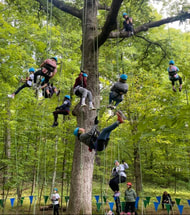 Climbing in a Park Near You There is plenty of excietment to be had, even if you return time and again to the same tree; as many of you do with our Rec Climbs in your local park. This is part of the reason why we partner with numerous municipal Rec Departments, to introduce and make the recreational tree climbing experience accessible to as many people as we can. Most people have never seen or heard of climbing tall trees until they saw it in their Rec Department's Activity Guide. Some happen upon us during a stroll in the local park. However you first learned of us, our Rec Climb programs likely played a part with you and your children's introduction to this wonderful activity. 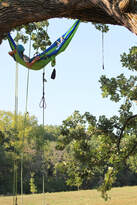 Climber relaxes and enjoys the view during an Open Climb Climber relaxes and enjoys the view during an Open Climb Branching Out Into New Trees We offer our Open Climbs so returning guests can change it up and enjoy climbing in a different tree. Not only do we pick our favorite trees for these climbs, we get to share the experience of hammocking high above the ground. We meet a large number of new climbers at these climbs as well given they are offered on weekends (Rec Climbs primarily offered on weekdays). Under the guise of just another fun thing to do while tree climbing, the hammock actually adds a level of challenge as getting in and out of it while hanging on rope further engages a climber's problem-solving and creative thinking skills. Since our Rec & Open Climbs are open to the general public and do not require experience, our procedures and the situations can be limiting to some climbers. 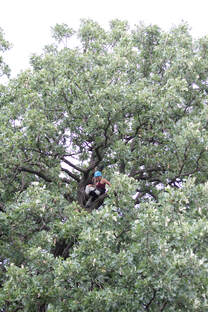 This advanced climber took advantage of the opportuntiy to climb the facilitator's rope to the top of the tree. This advanced climber took advantage of the opportuntiy to climb the facilitator's rope to the top of the tree. Out on a Limb Our Open-Advanced Climbs cater to people who have already climbed with us. This means that you are likely sharing climb-time with others who have worked through the initial fears and learning curve that limits first-time climbers. Open-Advanced Climbs attract participants who have really taken to the climbing experience and want to do even more up there. Climbers who are more comfortable at-height, would like to try new challenges, and excited to expand our movement around the branches. There are participants who are still working through fears of heights or maybe simply enjoy swinging. The common factor among the participants who come to these climbs is to take advantage of the longer sessions and not having to wait in line. There are more ropes than climbers, fewer people, and everyone has climbed with us previously. That enables us to allow climbers to try advanced challenges and more movement - like walking out further on a limb. We can even have a climbing guide in the tree to help participants work on various skills next to each other. Professional climbers enjoy much more movement and freedom when climbing, whether reaching higher points or more lateral movement and use of the climbing knot. Each month we offer up a new experience that we cannot allow in Rec & Open Climbs. Former students of our learn-to-climb classes are often in these climbs as well, working on the same skills; which makes for an exciting dynamic! Aspiring climbers of all levels, enjoying tree-time together. Each person focussed on their personal experience and intention for the day. For me, these types of experiences are what make the climbing experience more enjoyable, provide greater connection to the tree, and promote personal growth. If you or your child have climbed with us before & would like to continue to pursue the many benefits and rewards of climbing trees, I encourage you to learn more about our Open-Advanced Climbs. They are a great option for those who are too young learn to climb on their own and those not ready to make the investment in the equipment. There are a few of reasons why certain trees are special to me for climbing. Sometimes it is for the connection I feel to the tree, a particular challenge it may present for climbers, or because it provides an experience unique for those who head into the treetops. I am often asked if I have a favorite tree to climb. It's hard to narrow it down to a single tree, but here are four of them and what I enjoy about them. Each year I select a number of these favorite trees for our Treetop climbs (Open, Open-Advanced, Adult, and Girl Scout Open Climbs). Here's why they are special to me and may help you decide if you'd like to climb it with us. Pearl 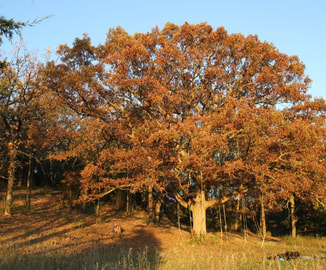 Pearl in fall Pearl in fall Pearl is one of my favorite trees. Growing at the base of a ridgeline formed during the last glacial period, this white oak is one of the older trees in the stand of oak & hickory overlooking the restored prairie. While understory plants have filled in the oak savanna that stretches the length of the ridge, park management is returning the area to the splendor of the natural savanna and prairies common to southeast Wisconsin in it's pre-settlement days. (Pearl is our climbing tree in Mukwonago Park) Having grown in open sun in its younger years, Pearl has developed a broad spreading crown with numerous large branches, an eye-catching form, and a broad trunk that is firmly rooted in the fertile soil. The number and span of the branches are part of what make this tree an enjoyable one to climb. There are several branches to explore and plenty of comfy spots to lay your head back and enjoy the hours pass by. 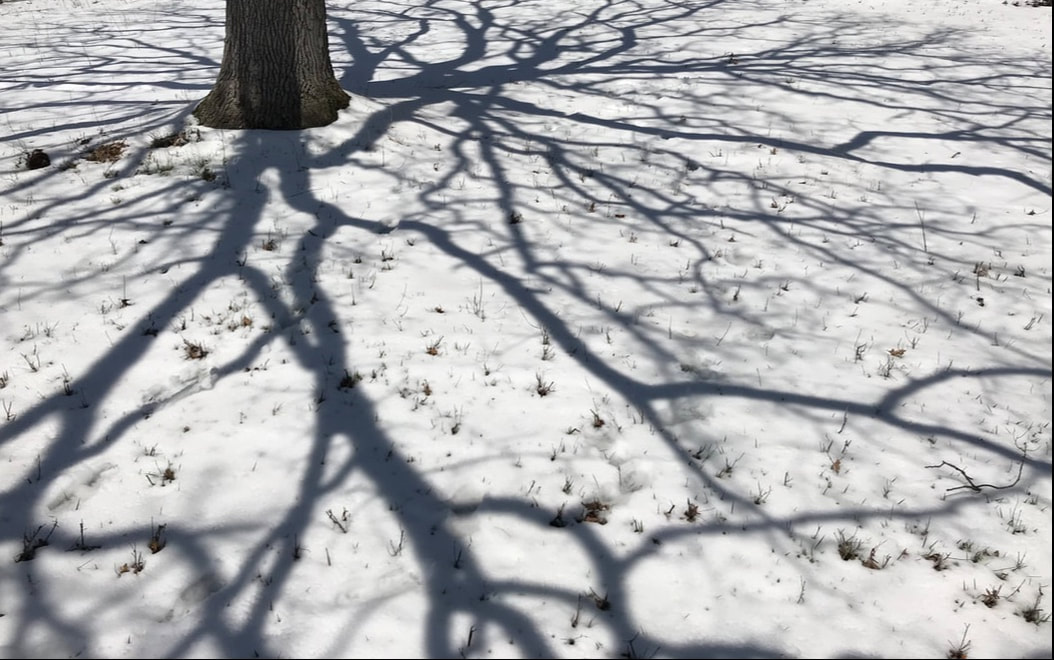 Pearl branching structure Pearl branching structure Taking time to look at the other mature trees along the hillside surrounding you, you can still make out the structure of the savanna before the understory and invasive plants crept in. Climbing late in the day may provide the opportunity to enjoy the rays of the setting sun. Winter climbs are a treat when the sun casts shadows of the weaving branches on the ground below. After taking time to play in the branches, you can head to a special place at the top. A fork in the branches at the very top form a small cradle that you can stand in, placing your head within feet of the uppermost leaves. Looking south, an opening in the branches provides a window where you can take in the view of the horizon. That is one of my favorite places to be in Waukesha County. The Woodfield Oak Since first meeting this tree in Woodfield Park after moving to Waukesha over 20 years ago, I have returned regularly to sit in its shade. It has often served as a place to quiet my mind and enjoy my lunch break. The form reminds me of the live oaks that grow in the Southeastern U.S. with their sprawling branches. It is about 55 feet tall and the branches reach out about 85 feet from tip to tip! Two large lower branches scoop down to the ground, ready to embrace you like outstretched arms. It is a special tree…and why I have not found the right name for it yet! The tree is upwards of 200-225 years old. Having sprouted from an acorn in the late 1700’s to early 1800’s, this tree was already a modest sized tree by the time Wisconsin became a state in 1848. With broad spreading horizontal branches, this tree is a favorite amongst climbers as they allow for long limb-walks and great for taking big swings on your rope. Since peoples’ comfort with heights varies, I love introducing students and public climb participants to the tree as there are great branches to practice skills or play from 7 to 40 feet above the ground. As the crown spreads and trunk heads towards the sky, two main stems form to provide a pair of high points in this tree. Reaching the top of either one, you will find yourself standing with your head near the uppermost leaves of this amazing tree. Captain Tony Fox Brook Park features a number of beautiful bur oaks & our particular climbing tree grows near the bank of the lake. Captain Tony is a great tree, providing shady branches to get out of the summer heat and enjoy refreshing views of the swimmers and kayakers on the lake below. With an upright trunk that forks into a few limbs, there are some great spots where you can pause and explore. Some of the branches allow for swinging and a taste of moving about the branches. 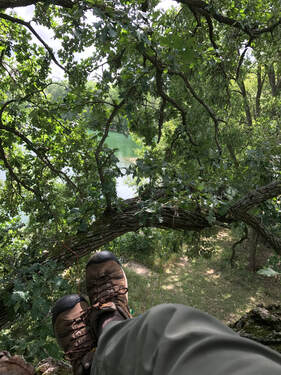 Kicking back in Captain Tony Kicking back in Captain Tony Captain Tony has a nice trunk route, which is when your climbing rope hangs down alongside the trunk. I enjoy trunk routes because I can touch the large limbs, feel the bark, and form a closer connection to the tree. For many climbers the challenge presented by being against Captain Tony's trunk may prevent them from making it past a particularly tight spot on the way up. Those who are able to adjust their ascent technique, use the trunk to their advantage, or able to persevere with determination are able to get past this point. Once above it, you are rewarded with a chance to stand at the point where the large limbs begin to form the crown. Standing there, energized and beaming with satisfaction, you will look up to find a clear route to the top. Watching others successfully make it past that difficult spot and seeing them beam with pride for the accomplishment is a highlight of the day for me. A Boost Up It is not always about finding the tallest tree to climb. Most of the time I am looking for an experience or something unique a tree may provide. The swamp white oak in Horeb Spring Park is a pretty tall tree for our area, but where it is growing provides something that all climbers can experience regardless of how high we like to or are able to climb. The tree grows on a hillside that makes for a popular sledding spot in winter. From spring through fall, this slope presents a unique experience for our climbers. As soon as your feet leave the ground & you are hanging on rope, the slope is no longer a concern for you. What it does do for a climber is change your perspective of height depending on the direction you are facing. Facing up-slope you can see the ground and may not feel anything different than when climbing trees on level ground. As you rotate and the view down the hill comes into your field of vision, you feel an interesting sensation of being higher than you actually are. 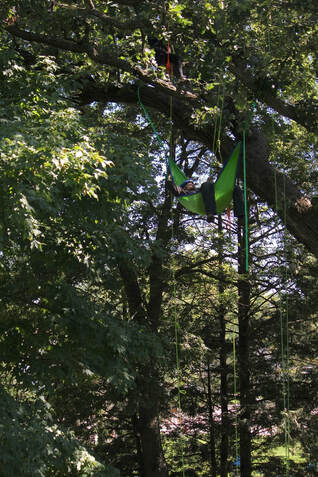 Hammocking at 20feet with the sensation of being about 40 feet from the ground Hammocking at 20feet with the sensation of being about 40 feet from the ground With trees growing at the bottom of the hill, when you look directly across to them you will be peering into higher points of those trees. Your senses will make you feel that you are just as high in your own tree. That sensation paired with the fact that you can still climb high in this tall tree will you give a boost of energy and allow you to check your comfort with heights. The sensation of feeling higher than you are is due to your orientation relative to the surrounding trees and landscape. This is something I look for when heading out to climb trees in the forest. Walking a ridgetop, I don’t necessarily need a tall tree, I just need a tree that can provide a view over or between the tops of the trees downhill. We often drive or hike to cliff tops to enjoy the view. With rope and saddle in hand, I just need to find a good tree on top of a ridge, cliff, or hill to get that extra boost above most people's perspective.. (Note: some of the experiences and climbing techniques described above may not be available at all Treetop climbs. Advanced techniques like limb-walking or multi-pitch climbing to get to the very top are covered in our Learn-to-Climb classes and introduced with modifications in our Open-Advanced climbs. Open Climbs feature a hammock.) 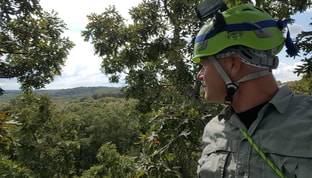 There is a sensation you get when sitting at the top of a tree, looking out across the tops of the surrounding trees and forest canopy. Taking a look down to the ground below, your body buzzes from the excitement of knowing you are in a special place. A place very few people get to visit. You have climbed to the top relying solely upon your own ability and determination. You have distanced yourself from the stressors of your day, quieted your mind, and can begin to reconnect with yourself. Some of these experiences leave a lasting impression. I can close my eyes and transport myself back to specific experiences: sitting on a branch at the top of a 200’ redwood, inhaling the scent of the needles atop a 110’ eastern white pine, and watching storm clouds move in the distance from my perch near the top of a 55’ white oak. Recreational tree climbers enjoy these types of experiences regularly, often searching out trees that provide the opportunity for a unique experience. How High Can You Climb One of the most common questions I am asked is whether I have climbed a redwood. The assumption being that the higher the climb the more enjoyable it is. My experience at 200’ was memorable and I do enjoy opportunities that allow me to climb higher than I have been before. For some people, climbing high is energizing. For others, frightening. There is great variance in the height at which each person feels is high enough for them. If you have climbed ladders, towers, or trees, you were likely aware of the stark differences between being at 15 feet and at 40 feet. When secured by a rope and safety equipment, the height at which you are comfortable climbing to is likely to increase. If you are looking for height, then you’ll obviously want to search out the tallest trees that grow in your area. Eastern cottonwood and eastern white pine are two species that can reach over 100 feet in Wisconsin. Even if you are not able to find a suitable tree for climbing to these heights, there are other ways to enhance the sensation of increased heights. This can be done by climbing trees on hillsides, ridgetops, or atop a bluff. Once you leave the ground, your perception of height is relative to your point of view. For this reason, if your climbing tree is situated higher than the landscape in your field of vision, you will experience an enhanced sensation of your height relative to the ground directly below you. While height is part of what makes climbing trees exciting, it is only one aspect of what tree climbers enjoy about climbing. 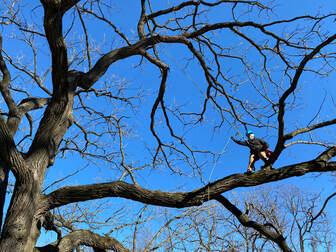 Out On A Limb Since trees are 3 dimensional, for many climbers the joy of a climb lays more in the branching characteristics of the tree. They search for trees that have a lot of large branches that spread out over a large area. When growing in full sun, oaks, maples, and others tend to develop a broad-spreading crown. This type of branching structure provides opportunities to maneuver around the branches. This shape also allows the challenge to walk on branches and traverse from one side of the tree to the other. Lateral movement across the crown of a tree requires additional skills and techniques then what is used when climbing a tree with a strong central trunk like a pine or spruce. Stimulate the Senses If you are familiar with aromatherapy and its ability to promote health and well-being, you are likely to understand why climbers may spend an afternoon in the branches of a spruce tree. The essential oils industry is very much aware of the beneficial properties of trees considering the number of tree oils available. With some climbs, my sole intent may be to head up to where I can find a branch to lay back on. With eyes closed, my body is tuned into the movement of my branch as the tree responds to the breeze. Your sense of balance falls into this rhythm in much the same way as when the waves gently sway your boat on open water. When a tree with nice horizontal branches cannot be found, a hammock can provide a comfortable place to rest high in the branches. Close your eyes and you will find it easy to drift off to sleep. 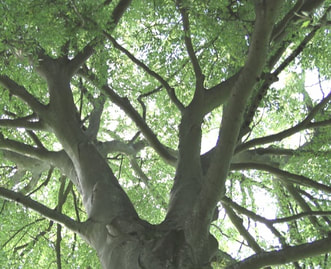 Bark texture varies widely between types of trees. American beech has smooth bark, bur oak is rough, and white cedar bark is soft and fibrous. Not only can you enjoy the different textures by running your hands across the bark, but the atmosphere within the tree canopy varies in a similar manner as the ambience between rooms with hard wood floors, tile, and carpeting. Let’s not forget the mighty tree itself. You may be drawn to a tree simply because it catches your eye and inspires you to venture upward in search of the pleasures it holds. Often times the trees we are climbing are much older than ourselves by a hundred or more years. They may have been planted by a relative a few generations back. Trees hold a history of changes they’ve seen in the area around them. If you sit in the branches long enough, you may be able to find connection and heightened awareness of your place in time. Given the number of experiences and reasons you may have to climb a tree, the best climbing trees might be found in your back yard, a nearby park, or along a river in a remote woodland area. The number of experiences that await in the branches above are endless. All are exciting in their own way. You just need to decide how you want to spend your time and find a tree that is suitable for the experience. 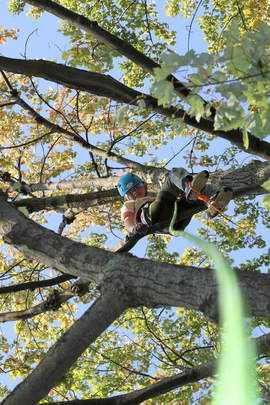 The confidence you have in yourself has a major impact on your level of happiness through life. When I am lacking in confidence as I take on a new task, I find myself immobilized by fear, uncertainty, and feelings of anxiety. My mind says things like, "I can't", "I don't know how", and "I haven't done this before". The view forward is obscured and the task appears overwhelming. Have you experienced this? Have you seen it in your children? Confidence plays an important role in everybody’s life. A person's level of self-confidence is directly related to the level of success they can achieve in pursuit of their life goals. Fortunately, as it is with most skills, we can maintain and build confidence through regular practice. Rock climbing and climbing trees are not only hobbies I enjoy, they provide opportunities for me to build confidence in my abilities. Working through the challenges I face in these hobbies can either build or diminish my level of confidence. Since tree climbing is a hobby I share with others, it provides me the additional perspective of watching others work through their own challenges. In working with many climbers through the years, I have noticed three important steps in building confidence: overcome self-doubt, split a large goal into a series of smaller goals, and focus attention inward. Overcoming Self Doubt "Whether you think you can or think you can't, you are right." Negative self-talk is the first thing that must go. As the case with most challenges, if you are to have any chance at successfully climbing to the top of the tree you will need to overcome self-doubt. This doubt tends to be triggered by fear. Each of us has our own fears to work through. Fear of heights. Fear of embarrassment. Fear of failure. Brand new experiences can be scary. For those facing and working through a fear, self-doubt creates an obstacle. Simply taking the initiative to try something new may be enough to help you overcome your fear. That first step might give you a boost in your confidence. Pair that with a little know-how and you are better able to pursue your goal for the day. My role as a facilitator is to aid you on your journey to reaching your goal. I can show you the technique yet I cannot climb the tree for you. Once you are on rope, my words are all I have to help you. More often than not, they are more than enough if I use them to convey positive thoughts and encouragement. Our fears express themselves in the words we use. This means that the words you use have a profound impact on how well you will perform. "I can't" seems to be the most common and inhibiting phrase I hear people say. These words are typically uttered within one minute of trying to climb; which leads me to believe they are spoken more out of reflex or conditioning. A coach or facilitator can help present a positive environment, but your self-talk often has the biggest impact. In order to move forward, we must stop the negative self-talk. We can replace it with positive words like, "I can do this" and "I am doing it." Speaking and thinking positive words and thoughts instills confidence. Building on a Series of Smaller Goals "What would you attempt to do if you knew you could not fail?" Sometimes our goal is so lofty that we have no idea how to achieve it or even where to begin. In order to reach the goal, we will need to break it down into smaller steps. There are many reasons why this approach leads to success, but I think a primary driver is that it allows us to realize successes at each step. With a small boost in confidence at each step, we are energized and ready to take the next step. With each successive step our confidence continues to grow. When Thomas came to climb with us his first time, his sight was set on climbing to the top of the tree. He came with confidence. As he began to ascend, his focus appeared to be strictly on reaching the top. Focused on that goal, he began to struggle because he tried to skip some of the steps involved in the climbing technique. The sit-stand technique is the foundation of the climbing method. Given his struggle, he naturally resorted to trying alternative methods like pulling with his arms and kicking his legs out. When he realized he was still not getting higher, his frustration began to build and his confidence plummeted. When trying to help a person build confidence, they must be allowed to work on their challenges. Personal growth happens through personal experiences of trial and error. Constantly telling a person how to do something or doing it for them robs them of these invaluable lessons. By having Thomas turn his attention back to the basic steps in the climbing technique, he was able to focus on the fundamentals needed to ascend. The steps necessary to reach his overall goal. With his focus back on using his legs versus his arms, he began to regain some of his confidence. After repeating the process a few times, he realized that he had ascended to 15 feet on his own. In a short period of time, his smaller goal of reaching the first branch was achieved. After a short break to acclimate himself to the height he had climbed (it feels a lot higher when you are looking back down at the ground!), he proceeded to climb higher. Eventually, his ultimate goal was only a few feet away. Thomas' goal of climbing to the top was unachievable until he broke it down into smaller attainable steps. With each success, his confidence grew. With each boost to his confidence, he was prepared to take on the next challenge. Gradually, his ultimate goal came into focus. Do Not Compare Yourself to Others "It doesn't matter what others are doing. It matters what you are doing." Building confidence in yourself has nothing to do with other people. Confidence is understanding and knowing what you are good at or the value you provide. In order to build confidence, you must be focused on yourself and your own experience. When Thomas began to struggle, his frustration was further compounded when he noticed that others were higher than him. He lost confidence when he viewed his slower performance compared to the others as a reflection on his ability to succeed. His ability to climb had absolutely nothing to do with how well the other climbers did. Comparing himself to others only allowed negative self-talk to return and diminish his confidence. Almost like a light switch, when he returned his focus to his own progress, his confidence returned immediately. Hobbies That Build Confidence “The more risks you allow your children to take, the better they learn to look after themselves.” I value activities that challenge and provide me opportunities for growth. Climbing trees for both recreation and work as an arborist has had a tremendous impact on me over the years. These experiences drive my desire to make recreational tree climbing available for others. In doing so, I have seen it have the same impact on those who climb with us each year. From April through October, I am surrounded by people. My weeks are filled with facilitating climbs and teaching classes. One of the most common bits of feedback I receive is in regard to the affect that tree climbing had on the participant's self-confidence; whether it is a parent who has observed it in their child or an adult who has returned to the treetops. The climbing you get to enjoy during our events is not only exciting and fun, it will provide a confidence boost that you can take with you as you pursue new challenges and goals in other areas of your life. With confidence, happiness and success follow. Our Beginning Tree Climbing classes begin in March and public climbs start in April. Until then I encourage you to seek out hobbies and experiences that can help you and your children continue to build confidence until you can return to the trees with us! All new climbers learn to ascend the rope using beginner techniques, which we teach at all of our events. With time, some people advance to faster and more efficient techniques that Curt demonstrates in this video. It’s the technique of climbing rope that gets you high up into a tree, no matter your level.
I spend time with trees by sitting beneath them or hiking through the forest. Of course, I also like to climb them. I’ve enjoyed climbing trees for as long as I can remember. The oak in our front yard in Miami was one of my favorite climbing trees growing up. It was a rite of passage when I could finally jump high enough to grab hold of the lowest limb and pull myself into the tree without any assistance from my older brothers or standing on my bike. “I used to climb trees.” I hear this quite often when I tell people what I do. After sharing enjoyable memories, some people follow up with, “it was so much fun.” Therefore, it begs the question, “Why did you stop?”
When most people think of tree climbing, they tend to envision free-climbing, using hands and feet to climb branches without the aid or safety of rope. Technical tree climbing utilizes ropes and saddles to climb trees. Each style of climbing offers a variety of benefits and experiences for the climber. Free Climbing Growing up in Puerto Rico and Florida, we climbed numerous rubber trees (Ficus elastica). Our hands coated in sticky sap enabled us grip and swing from their aerial roots like Tarzan! We could shinny up the schefflera trees and climb onto the roof of our house. We climbed and picked countless mangos, loquats and tangerines from trees around the neighborhood, bringing them home to feast upon them at the top of our favorite climbing tree. Those days of free-climbing involved smaller and even some medium sized trees. For the most part, climbing a tree in this manner requires that the tree have enough branches to provide hand and footholds. Free-climbing small trees calls upon our primal instincts as we explore these living jungle gyms. Free-climbing a tree without the use of rope, you are exposed to a higher risk of falling. I think this is the primary reason people are discouraged or even forbidden to climb trees, even though playgrounds are filled with structures for climbing and enabling children to get off the ground. The simple act of climbing develops a person’s hand-eye coordination and motor skills. Each step of the way while tree climbing, you are determining where to place your hands and feet to gain vertical height. Trees do not have a standard arrangement of limbs or spacing between branches like a fabricated jungle gym. Planning a few steps ahead is a necessity as the path is not a straight line up. Returning to the ground can be even more challenging. An adrenaline rush and flood of emotions accompanies this type of play. During our time in the tree, we are also rewarded with releases of “feel good” hormones like endorphins, dopamine and serotonin. You don’t need to know what these are because you can feel their effects even if you don’t know their names. I love reading the research about such benefits today as that helps fuel my passion for providing an incredible experience for people to spend time in the trees. Back then, all I cared about was that climbing trees was a fun and exciting way to spend my day.  Technical Tree Climbing When we moved to St. Louis, we had a sugar maple that could be climbed, but it wasn’t nearly as much fun as my previous climbing tree. Aside from the maple, we had oaks, hickories, and elms that were too tall to climb since the lowest branches were about 20’ high. If you have the desire to climb into taller, larger, older trees, you are out of luck if they do not have low and small enough branches for climbing. Thankfully, ropes, saddles and specialized techniques allow us to climb into these magnificent trees. Climbing rope requires a unique set of motor skills and spatial awareness in addition to those skills we developed as free-climbers. It also requires the use of muscles you may not have known were there! Sitting back in your saddle and letting the tree and rope support your weight has an energizing effect. Once you climb into the crown of the tree and can play in the branches, you are continuously transferring your weight and sense of security between sitting in rope and being supported by a branch. The transition back and forth brings new challenges. This is part of what makes technical tree climbing a lot of fun and different from free-climbing. Once you begin to master the balance between using branches and using rope, you are better able to climb and explore the tree at will. You are able to enjoy the freedom of spending time in the branches without having to hold on. Another key difference is that, with rope, you can climb much higher. Some of the taller trees in Wisconsin allow us to ascend over 100 feet above the ground. The tallest trees in the world allow climbers to reach heights over 350 feet. While these heights sound impressive, the reality is that most people are challenged and impacted by reaching heights between 10 and 35 feet. The trees we climb around Wisconsin are perfect as they allow us to play in this realm. For those who like pushing the limits, I often include a few ropes that reach 40-50 feet during my climbs. In private excursions and guided climbs, we go even higher. In the end, the height each of us is most comfortable at will vary greatly. Using rope and saddle enables you to progressively challenge yourself to reaching new heights. Climb Trees
As a kid, I free-climbed trees because I didn’t know any other way. These days I climb using rope and saddle. Thanks to this hobby, I am able to explore amazing trees and chase views that few people will ever get to enjoy. I doubt my parents ever stopped to ponder the emotional and cognitive benefits I was receiving during my time in the trees. They knew it was important for kids to play outside because they could see the differences in my demeanor between those days and the ones I spent mostly inside in front of the tv and playing video games. Today, I notice differences in myself during and following my time in the trees. When I reflect back on my childhood, I am grateful my parents allowed me to climb trees. As long as you take into consideration that the tree you are climbing is a living being and do what you can to minimize your impact on the tree, I encourage you to get out and enjoy the trees. Take your children and loved ones with you. *Fine print: prior to entering a tree, I perform a thorough inspection to assess its health and structural integrity. There are a number of issues and conditions that can make a tree unfit for climbing. If you are unsure of the condition of your trees, please contact an ISA Certified Arborist and have them assess your tree (yes, even the small ones). If you are interested in climbing tall and mature trees, give me a call! I take a lot of pictures during our climbs. The experience is different for each climber, each person benefiting from it in their own way. Describing the different benefits that come from climbing trees can be difficult. But you can see it for yourself in this week’s video. Register for a climb today and come experience it for yourself!  Curt and Dr. Gathright Curt and Dr. Gathright Dr. John Gathright was an author and motivational speaker, not a tree climbing expert. He wrote a book about pursuing your dreams, and at one of his book signing events, he was approached by a woman. Speaking from her wheel chair, Toshiko Hikosaka told him of her dream to climb the world’s largest tree and that she wanted him to help her. He was not a tree climber and had no idea how to climb such a tree, but he wanted to help her achieve her dream. Three years later, Gathright and Hikosaka reached the top of a giant sequoia. At 63 years old, she was the first paraplegic to climb a tree to this height. Her climb that day culminated in triumph, wonder and exhaustion. They spent the night in the top of that 243-foot tall tree, on the branches, under the stars. Just as that day in the bookstore had set the ball rolling for their 3-year journey, the climb to the top of the sequoia was the beginning of the next chapter. Upon returning to Japan, demand for Gathright’s tree climbing adventures inspired him to cut his own path forward. Given there were no tree climbing schools in the country at that time, he had to start at the very beginning. It was a delight for me to be able to attend a presentation of Dr. Gathright recently. He is a pioneer in using recreational tree climbing in therapeutic and rehabilitation programs, and I have been inspired by his work for a number of years. To hear him tell his story of the legwork he had to go through was amazing. Sometimes It Is About The Numbers He had to find research that supported his idea of establishing tree climbing as an effective and legitimate form of therapy. No research existed at that time, therefore he realized his next course of action was going to have to be the pursuit of his PhD studying and testing his hypothesis. His doctoral thesis looked at the physiological and physical differences in individuals between their climbing living trees and climbing a concrete structure. In both instances, participants were climbing to elevated heights and performing similar tasks. In analyzing the data, there were clear differences between the 2 experiences. When climbing trees, participants experienced less pain and fatigue, experienced greater vitality and clarity of mind, and reported feeling a greater feeling of self-worth versus when they were climbing the concrete structure. Tree climbing had produced an increase in positive emotions and reduction in negative emotions. His further studies revealed and measured reductions in participant levels of stress, tension, anxiety, depression, and anger after climbing trees. Not only did his research show the positive effects of tree climbing, it revealed that it wasn’t simply the climbing that was providing the benefit. There was a marked enhancement of the effects when the participants were climbing trees. Gathright had provided the scientific basis behind his TreeHab and Tree Therapy programs. Meet Your Therapist My first ascent of a tall tree early in my career had a profound impact on me physically and mentally. My muscles enjoyed the physical exertion, but I was exhausted. I was energized by the height I had reached, at the same time nervous. Through all of the hormones flushing through my body, I found mental clarity and focus. I was energized, yet I was at peace. I never measured the effects to confirm in what ways and by how much climbing trees changed me, yet I walked away from that climb relaxed and inspired. And every climb since. Over 20 years later, I came across the research of Dr. John Gathright that identified and quantified the effects of climbing trees that I had personally experienced. From its origins in 2000, TreeHab has worked with thousands of children with physical disabilities and emotional trauma. Gathright and Tree Climbing Japan have helped over 300,000 people of all abilities discover their inner tree-climber. As I listened to him share his stories of people he has worked with over the years, I was reminded of those who have touched me during my journey thus far. Tree Climbing Touches Lives I am involved with tree a climbing program for urban youth and people who do not have the resources to leave the concrete and asphalt landscape at will. Counselors and therapists utilize our climbing experience in their dealings with children facing emotional trauma, such as that related to the loss of a parent. It was interesting to hear him speak of programs developed for people with autism and ADHD. While the experience and benefits of tree climbing have a profound impact on these participants, it appears that TreeHab is also having a promising impact on breaking down the stigmas associated with them in his community. I have seen the benefits first hand in dealing with a variety of people from all walks of life and backgrounds. While the majority of our climbers may not fall into any of these categories, every one of us benefits from the same effects that tree climbing provides. His words brought into focus for me that we each have our own inhibitions, insecurities, and unique qualities. Each of us may be at a different point in our journey through life, come from different backgrounds and face our own challenges; but, every one of us can reap the benefits of time in the trees. Stability provides comfort. Dealing with feelings of instability can provide for personal growth. Come along as we look at the tree climbing experience and the ways we transfer our feelings of security and stability from rope to branch. A discussion of Stability and Instability - how to enjoy your climb even more. |
AuthorAs a G.O.T.C. Recognized Master Instructor & Facilitator, I.S.A. Board Certified Master Arborist, and T.C.I.A. Certified Treecare Safety Professional, Curt has spent over 30 years dedicated to the study and care of trees. Categories
All
Archives
May 2024
|
|
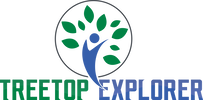




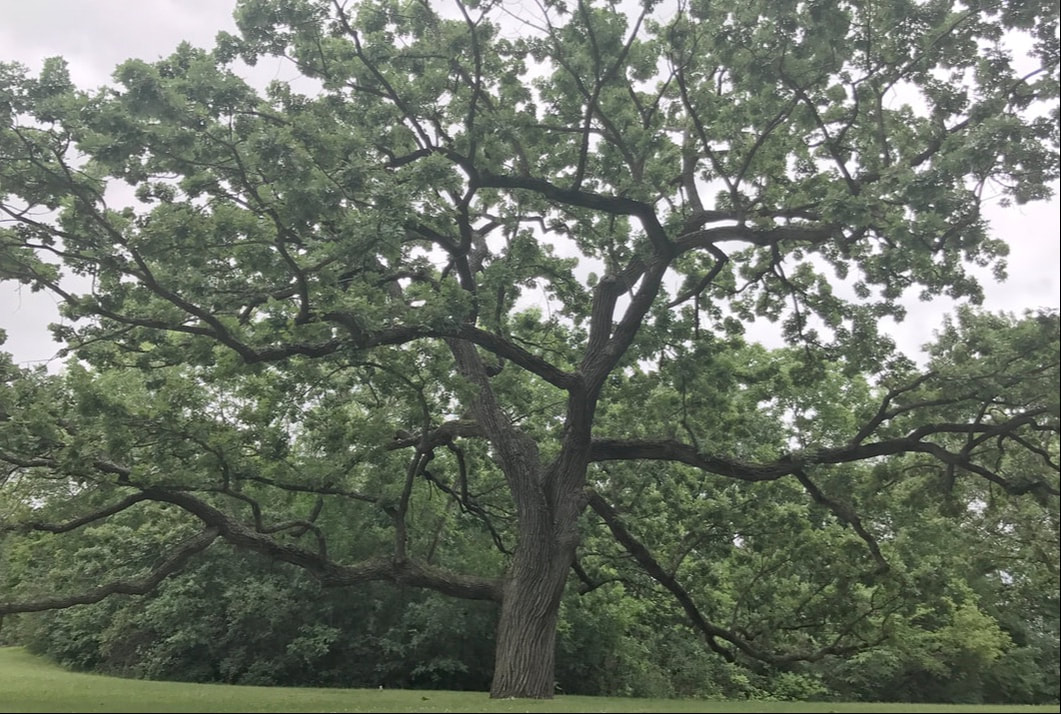
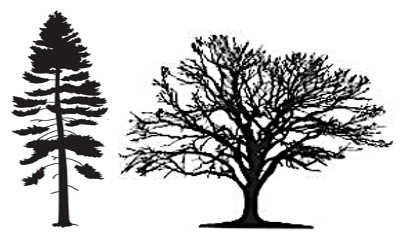
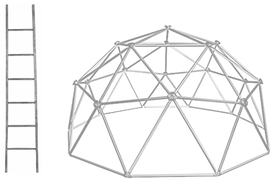


 RSS Feed
RSS Feed
